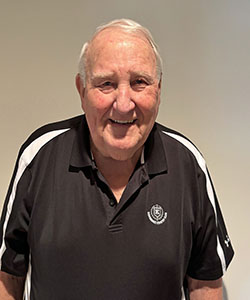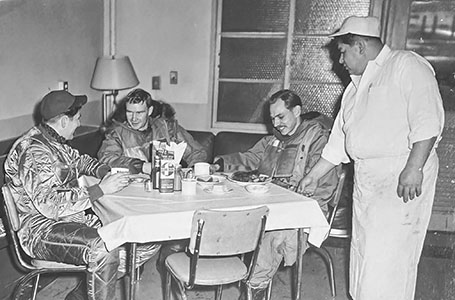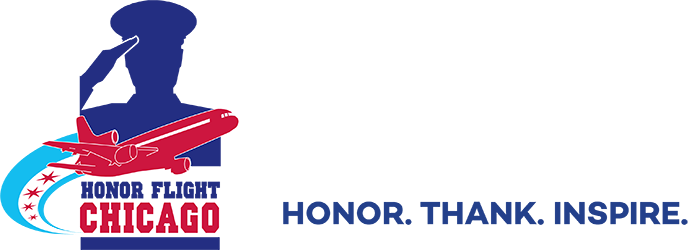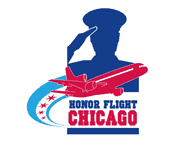Air Force Vietnam War DeKalb, IL Flight date: 05/14/25
By David Adams, Honor Flight Chicago Veteran Interview Volunteer
December 7, 1941.
Edward Bosic, age 8, and family had just finished Sunday dinner at home. His mother sent him to the nearby ice cream store for dessert. As soon as he entered the store its owner asked, “Did you hear what happened? We got bombed?” Ed had no idea what that meant until he returned home. He had never heard of Pearl Harbor but has not forgotten it to this day. Fast forward 17 years. Ed is now an Air Force fighter interceptor pilot flying the North American F-86L Sabre Dog and training Japanese fighter pilots at Misawa Air Base, Japan for the defense of their own country.
Ed grew up in Tire Hill, Pennsylvania, population 400, which is near Johnstown in the southwest corner of the state. He graduated from Conemaugh Township Area High School in 1951. Off he went to the University of Pittsburgh to pursue an engineering degree. His military options were the Army or the Air Force. Ed preferred taking to the air and joined Air Force ROTC. Upon graduation in June 1955 Ed received his commission as a Second Lieutenant. Before reporting to flight school, he worked as an engineer at Cleveland Graphite Bronze Co., in Cleveland for several months.
Air Force flight training
His first month on active duty found him at Lackland AFB, San Antonio for orientation. Then on to pilot training. The first phase of Air Force pilot training was Primary. Ed reported to Bainbridge AB, Georgia. Flight training was conducted by a civilian contractor, Southern Airways. He spent six months flying first the Beechcraft T-34 Mentor and then the North American T-28 Trojan. After 80 hours in these piston engine trainers, he mastered Air Force flight discipline and procedures. “I liked both airplanes. Very stable to fly.” One incident at end of his Primary training stands out. To accumulate the last bit of time enough to meet graduation requirements, Ed launched solo in his Trojan. His objective: fly down to Panama City, FL and “buzz the beach.” One might say it was a rite of passage to the next level.
The last stage of flight training is Basic. Ed headed for Laredo AFB, Texas. There he flew the Lockheed T-33 Shooting Star. An essential component of the flight curriculum is instrument training. Ed remarks that it “was intense” and conducted “under the hood”. The outside was obscured by a hood inside the rear cockpit from which the student pilot flies. He eventually could fly an entire sortie from takeoff to landing without visual references.
Ed earned his wings as a member of Class 57L. The selection of an airplane the newly-minted pilots would fly was based predominantly on grades. Ed was a top student. Choices for his class were among training instructor pilot, fighters and multiengine. With a four-year service commitment Ed could have extended it an additional four years and be “re-ranked” at the very top of the class for airplane selection. He declined. He passed on the instructor school and multi engine options and selected the North American F-86D “Sabre Dog” fighter interceptor. A transonic jet single seat interceptor, it was capable of a top speed of 621 knots and a service ceiling of 50,000 feet MSL.
His advanced training and transition to F-86D fighters occurred at Moody AFB, Georgia. Flying the T-33 for three months in the “All-weather” school, pilots flew extensively “under the hood”. Ed spent the following three months in the F-86D learning to fly it in all weather conditions, mastering its systems including its all-weather radar. Weapons training would be accomplished in an operational fighter squadron. He graduated from Advanced in the fall of 1957.
On the whole Ed emphasizes, “I remember the training as being quite rigid and sometimes quite intense. All of the instructors were all top notch in their mission of developing pilots. All of them had their unique way of proving their point.”
Misawa AB, Japan
Ed received his fighter assignment to a base in Japan. Flying over on a commercial jet he arrived at Tachikawa AB in early November. His base in Japan was to have been on Hokkaido. Since that base was being closed, he was reassigned to Misawa AB, Japan. He had to wait several weeks for his orders to Misawa and the 4th Fighter Interceptor Squadron. He signed into his squadron just before Thanksgiving. He recalls that Misawa is approximately 400 miles north of Tokyo, on the northeastern part of the main island of Honshu. He quickly learned that, unlike the Tokyo area, this region of Japan is rural and known for its slower pace of life. The Air Force stationed three squadrons at Misawa AB. The 4th FIS flying 25 F-86Ls, a RF-101 reconnaissance squadron and an F-100 squadron. Ed recalls that the L model had extended wingtips and wing leading edges and with an uprated engine and new avionics.
He rapidly found that the officer’s base lodging, BOQ, was “terrible, austere”, resembling WWII-like barracks. Breakfast of toast and coffee was available at squadron operations where a kitchen had been set up. Lunch options included sandwiches made by a Japanese cook. The lunch fare was “very good”. The Officer’s Club was the place for dinner.
Ed remembers that “Our “work week” was based on a 4-day week. One day per week was spent on flying the T-33 where we practiced weather simulation flying. The second day was spent on flying the F-86 on practice intercepts and weather simulation. The third day was spent on 24-hour alert where you were on alert for 24 hours in defense of Northern Japan. The fourth day was an off day. This experience greatly enhanced what it meant to depend on your wing man and your wing man depending on you. On alert, our mission was to intercept unknown aircraft penetrating the airspace of Northern Japan.”
Weather always posed a challenge for the squadrons. Typical were rain, clouds, and snow. During the five months of November through March, the base could get up to 200 inches of snow. Ed’s superior Air Force training permitted him to successfully make ADF instrument approaches with a ceiling of just 100 feet. “Very precise flying.” He remarks that the fighter’s landing speed of 140 kts with drag chute and speed brakes deployed used up Misawa’s 10,000 ft runway “pretty quick”.
The F-86L carried only rockets which were designed to take down bombers. Unlike the F-86 models flown in the Korean War, it did not have a canon. The 24 “Mighty Mouse” rockets were carried in a retractable under-fuselage bay. Ed could select the number to fire at any one time: 1, 6, 12 or all 24. Training with the rockets involved shooting at a “rag”, a large banner towed behind another F-86L. Three or four fighters fired on the rag. After each pilot finished his firing passes, a T-33 took a close look to see if any hits had been made. Upon return to base the hits from the individual shooters are counted. The pilots also trained on a target closely resembling a “rocket ship”, about ten feet long by three feet in diameter. A squadron T-33 towed the target about a mile behind it. Firing passes were made on the target which was reeled back in and returned to the base. Ed emphasizes that the target practice naturally occurred over the sea.


24-hour alert
The primary mission of the 4th FIS was 24-hour alert. Four F-86Ls were hangered in the “alert barn” just yards away from the runway. Two pilots with fully preflighted fighters sat 5-minute alert and two others sat 30-minute alert. When the horn sounded, 5-minute alert pilots ran to their airplane, pulled the remaining safety pins, started the engine, taxied and took off. After the 5-minute alert fighters launched, the 30-minute pilots set up for 5-minute alert. Prevailing procedures were first in the air is the commander and the second flies the wing.
Flying over the ocean during the months from October to May the pilots wore a “moon suit”, anti-exposure suit. Ed recalls that donning it took ten minutes. The 5-minute alert pilots wore the suit and after six hours reverted to 30-minute alert without the suit. The threat the fighters confronted were Soviet bombers capable of reaching the United States. These were the multi engine turboprop-powered Bear and jet-powered Bison. When these bombers strayed too close to Japan the alert horn sounded. The fighters were easily airborne within five minutes to intercept them.
In 18 months at Misawa Ed scrambled eight times. Intercepts generally were made within 200 miles from Misawa and over the Sea of Japan northwest of the base. All intercepts were controlled by ground-based radar.
Scrambles
- During the Fifties President Eisenhower insisted that no U-2 spy planes were flying over the Soviet Union. On one intercept mission, after leveling at 40,000 feet, Ed asked where the “bogey” coming out of Russia was located. When radar told him it was well above him at 75,000 feet, out of their range, the fighters returned to base. Obviously, the airplane was a U-2, the only one then capable of flight at such an altitude.
- On a night scramble Ed’s wingman aborted due to an inflight emergency precluding his continuing the mission. Ed flew on alone. Radar controllers had picked up eight bogeys. A Soviet test ICBM was lost at sea and the eight bogeys, later determined to be fighters, were tasked with protecting the Soviet ships searching for the lost missile. Ed returned to base.
- During snow storms the Russians launched aircraft into the Japanese air defense zone to test the alert birds scramble response time. They could be Bear or Bison bombers and perhaps Soviet MiG 15 or 17 fighters.
- From time-to-time the squadron pilots brought a handheld camera to snap photos of intercepted Soviet bombers. To his knowledge none had successful photo op.
Japanese fighter pilot training
Ed’s squadron was tasked to provide four months of training to four pilots from the Japan Air Self-Defense Force. The fighter pilots, one major and three captains, spoke little English. Their interpreter was essential. Ed, with fewer than 500 hours at the time, acted as one of their instructors. All training sorties were necessarily single ship. The Japanese “student” flew the lead fighter and a squadron pilot the “chase” airplane. Asking Ed, “Were they very good ‘sticks’ [fighter pilots]?” Answer, “Yes, each one was an ace from WWII with five or more aerial victories against Allied airplanes during the war.”
Ed immersed himself in Japanese culture. He observed that the rice paddies surrounding the base were worked by farmers. Each officer employed a Japanese “houseboy” for his quarters. He didn’t go to the town where a couple of bars were frequented only by enlisted personnel. The squadron pilots’ schedule did allow for an occasional three-day weekend. Off to Tokyo to see the sights. USO shows came to base every month. Ed is very complimentary of the entertainers, bands and singers.
Ed’s tour at Misawa came to an end in May 1959. Arriving back at Tachikawa AB for his scheduled commercial flight to the States he learned that his flight had been cancelled. The flight dispatcher said, “we’ve been looking for you!” He was made a “courier officer” in charge of two Airmen and five bags of Top Secret documents. Armed with a 45-caliber revolver he boarded a C-97 Stratofreighter and marched to the very back with his troops and bags of documents. A refueling stop in Hawaii preceded the final stop in California. Accounting for the Top Secret documents took a day followed by his discharge paperwork. Ed received an honorable discharge after four years as an Air Force pilot.
Post- discharge
Returning home he enrolled in post-graduate night school at Case Western Reserve in Cleveland. The urge to keep flying drew him to the Ohio Air National Guard at Mansfield. Its 164th Tactical Fighter Squadron flew the Republic F-84F Thunderstreak fighter-bomber. The squadron’s mission was air-to-ground weapons delivery in comparison to the F-86L interceptor’s role Ed experienced in Japan. Living in Cleveland, he trekked 2 ½ hours to the base for airplane checkout and periodic flying. As he describes it, the F-84F needed more thrust from its engine to accomplish its many missions, meaning it was “underpowered”. In July on the 10,000 ft long runway the fighter “used all of it to get airborne” he recalls. He reluctantly left the ANG within one year.
Ed graduated with a Master’s Degree in Engineering Management from Case in 1962. For 46 years he owned and operated E.B. Inc., a DeKalb-based architectural and structural metals manufacturing company. Ed retired as company president just last year. Now a widower he revels in his three children and two grandchildren. One of his daughters takes after his wife who was a skilled artist. Their works adorn his home in DeKalb. He also enjoys golf with a group of like-minded seniors.
Reflecting on his service, “I am proud to have been a fighter pilot for the United States Air Force.”
Ed, enjoy your well-earned Honor Flight trip to Washington, D.C. with a multitude of other veterans!


